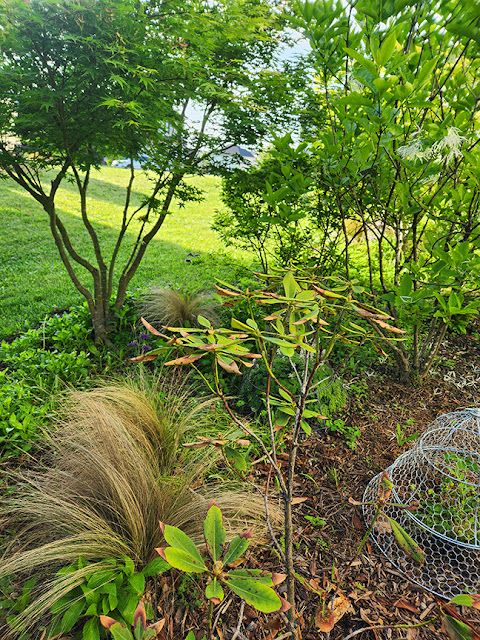 | ||
| Red Spruce forest. |
We were still on the Wildlife Trail, which is about 1.6 miles long. Eventually we crossed a stream, and the terrain began to change. The forest became denser, darker, and mossier, the ground rockier. We must be getting closer to the junction with the Rohrbaugh Trail. It was getting on toward four in the afternoon.
 |
| Getting on the Rohrbaugh Trail. |
The junction with the Rohrbaugh Trail was marked by a sign; one could see the trail dropping downhill on the right and the light through the trees hinted at the deep canyon beyond. Taking the left hand side, the Rorhbaugh Trail continues towards some towering cliffs. We crossed another smaller sod, where we saw a couple of Monarch butterflies--too far away to photograph. The bees were having a feast on the Goldenrod.
 |
| Bee on Goldenrod |
 |
| Heal-all (Prunella vulgaris) |
Getting closer to the cliffs one could see the mountains on the other side of the canyon through the Mountain Ashes in fruit. In this more exposed area, being drier, grassy spaces bordered by Rhododendons, mountain laurel, blueberry and huckleberry bushes opened up.
 |
| The western side of the mountains through the trees. |
 |
| Rhododendron and Mountain laurel meadows. |
Ground pine and reindeer moss grew under the dwarfed spruce on the sparse soil near the cliffs.
 |
| Ground pine spore structures with reindeer moss and ordinary moss. |
 |
| Side paths near the Rorhbaugh cliffs. |
Climbing over the rocks toward the overlook, one can begin to appreciate the size and splendor of this vast wilderness--the view is spectacular!
 |
| Climbing towards the overlook. |
 | |||||||||||||||||||||||||||||||||||||||||||||||||||||||||||||||||||||||||||||||||||||||||||||||||||||||||||||||||||||||||||||||||||||||||||||||||||||||||||||||||||||||||||||||||||||||||||||||||||||||||||||||||||||||||||||||||||||||||||||||||||||||||||||||||||||||||||||||||||||||||||||||||||||||||||||||||||||||||||||||||||||||||||||||||||||||||||||||||||||||||||||||||||||
| View from the overlook. |
 |
| The Rorhbaugh Cliffs. |
Getting back to the main trail we wandered through through thickets of Rhododendrons and Mountain Laurel so dense they overhung, forming tunnels.
 | |
| Getting back on the main trail from the overlook. |
 |
| Rhododendron forest. |
Beyond the climax of the overlook, the trail stepped back into the shelter of the forest. The forest once again changed character, becoming very mossy and lush. The rocky trail was intersected by a number of small streams and run-offs, and the Rhododendrons were taller, shaded by red spruce and hardwoods. The tree roots intruded upon the trail as much as the rocks, making it difficult to walk smoothly. The muddy patches continued, and we had to skirt around them as best we could.
 |
| The Rorhbaugh Trail beyond the overlook. |
 |
| Big Belled Web Caps (Cortinaria largus) |
 |
| Stream on the Rohrbaugh Trail. |
Mushrooms began to appear again, though not in the profusion and variety as on the Wildlife Trail. Mosses carpeted the sides of the trail and rocks, Sphagnum moss in the wetter parts.
 |
| Moss on the sides of the trail. |
 |
| Sphagnum moss. |
The tall trees, Rhododendrons, and mosses gave the forest a magical, fairy-land atmosphere. Imagine how lovely it would be when the Rhododendrons and Mountain laurel are in bloom!
 |
| The Rorhbaugh Trail |
This was the last photo I was able to take--my phone ran out of power completely right after this. The rest of the hike was very similar, rockier and muckier in some places, up and down, mostly up, with many beautiful sights. We harvested two more Lion's Mane mushrooms along the way, fortunately well within our reach without needing any sticks. More than enough for a great supper for both of us and our spouses!
We were totally exhausted by the time we reached the trailhead and my friend's car, well past six PM. We'd been hiking for over five hours to cover the 5.2 miles of both trails. We drove back to my car at the Wilderness trailhead and drove down the dusty mountain road as the sun was leaving the tops of the trees on the heights--it was after 7 PM and starting getting dark. We were still a two and a half hour drive from our homes--I didn't get home until a quartet to ten that night.
I "left it all" as they say, at Dolly Sods that day, but I'd love to come back in the spring to see some of the bogs in the lowlands, as well as the Rhododendrons and mountain laurel in bloom!
































